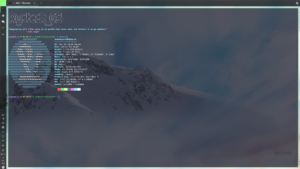Creative work is challenging – both in the act of actually creating and in the act of finding time to do so. More than half the battle in creating new content (of any sort) is finding the time and head space to simply sit down and do it.
Outside distractions suck so much time, especially if that time is a few hours one afternoon to work on a your company’s blog posts. These distractions, like customers in your shop, children trying to break into your home office, or a contractor working on your building, can all get in the way of sitting down at the computer to work.
But once you’re at the computer, you might even find the distractions beyond your open Word doc or WordPress admin panel are much more attractive and urgent than the work at hand. Emails, social media, news sites, and even needed technical updates can all suck the productivity right out of your block of work time.
So how do you overcome overwhelm when you sit down at the computer?
And, maybe more importantly, how do you curtail the “Twitter break” that turns into an hour-long trek down a rabbit hole of political debates or a sidestep into your Facebook feed and catching up with old friends?
Here are some helpful ways that you can cut the virtual clutter and get right to work when you sit down to create:
Schedule Time for Everything

You schedule your meetings, lunch break, and everything else that you do in your work day, but what about when you sit down at the computer? Cracking open your laptop screen might signal the beginning of a block of work time, but is that time as structured as the rest of your day is?
There are limitless possibilities when you open your browser and start to type, but don’t lose sight of your work day by frittering your time away on interesting articles or “urgent” emails.
Instead, combat the desire to distract yourself or take a little break from work by structuring your computer time.
It may seem trivial, but writing down a schedule and allotting specific periods of time for things like checking email, keeping up with the company Facebook page, or reading articles on current events in your field can keep you on track. Then when it comes time to create, you don’t feel guilty for not getting to other work, since you’ve got it scheduled in for another time slot.
The same goes for fun time on the computer. Sure, you might hit the keys after your kids have gone to bed and you’re working on your online side hustle. It’s been a long day, and you’re itching to just watch some YouTube videos about tiny living. Creating takes work, and you’ve been at that all day.
Before you close your browser and beat yourself up for wasting time, or ignore logic and give in to the temptation to fall into a YouTube wormhole for the rest of the night, give yourself a little time to do something you enjoy. Then get to work.
Employ Your Auto Responder

Email is one of the biggest things that takes unintended time away from the busy creative professional. If you’re a solopreneur, you’re responsible for fielding every email, from clients who need your work to financial reminders and info on your next networking event.
Your inbox is an essential tool for running your business, and if you’re like most professionals I know, your email is always open in another window or browser tab. You don’t want to miss that next important message.
But always being available might put a damper on your real productivity throughout the day.
While you certainly don’t want to leave clients and business contacts in the lurch, you don’t necessarily need to respond to every message in real time.
Determine Your Email Style
When you work on your daily schedule, pencil in time for checking on and responding to emails.
If you typically deal with a lot of back and forth emails in a day, use four half hour blocks to check on and send messages back and forth to key players.
If you need more time to craft responses and answer complex questions, schedule time to read emails in the morning, use work time to research and formulate responses offline, then log back in later to copy and paste these responses in as replies. Come back a little later for follow up, if need be.
Your autoresponder can help you stay organized and on task when it comes to managing your inbox.
In fact, if you don’t have the budget to splurge on a secretary or professional assistant, hire your autoresponder to fill that role.
Populate your autoresponder with essential information, like when you will be checking your email next, partners who can answer questions if you’re away from your inbox, and a telephone number where contacts can reach you if there’s an emergency.
The point isn’t to be off the grid during the in-between periods. You simply want to have time for email and time for other work.
Many professionals are taking this approach, and the autoresponder message is becoming more commonplace. Don’t be afraid to use yours to screen emails during your creative blocks.
Take a Social Media Sabbatical

Email isn’t the only online time sucker. In fact, I’d argue that it’s far lower on the totem pole of online time suckers, thanks to the popularity of social media.
A lot of companies struggle with limiting their employees’ use of social media, and some block popular sites altogether.
But if you’re a creative professional or solopreneur, you need to have access to various social media channels in order to promote your work and your brand. You might even leverage social media as a networking platform for seeking new business.
If you’re not careful, social media can easily suck away all of your productive time. Most creatives I know struggle with balancing their timelines and to-do lists.
So how can you manage to stay on task and keep your social media growth goals on track?
Perhaps a break can help
Take some time away from social media to help you gain perspective on what you’re really trying to accomplish on various platforms in the first place.
When you step back from your social media channels you can gather your thoughts and organize a clearer strategy that better fits your target audience.
You may even discover that your current approach or audience isn’t what best fits your brand and decide to change direction.
A social media sabbatical doesn’t have to be a total social media blackout – though it can be. If you find yourself drawn into drama on your personal Facebook account and spend more time interacting with friends’ posts than your company page, consider deactivating your Facebook for a week, month, or year.
You might balk at the idea of leaving Facebook or whatever other platform that you find you’re spending too much time on. After all, you’re probably there to promote your business in some way.
If your professional social media account can’t take a rest, even for a week, find someone who can operate the page in your absence – even if you dictate the posts.
When I quit Facebook for a year, I had my husband maintain my blog and business pages. He has a lot more focus when it comes to social media time, while I tend to get sucked into the vortex of cute baby pictures.
Use Social Media Timers

After you reactivate your social media account(s), make sure that the lessons you learned during your sabbatical don’t go to waste.
My favorite way to stay in control of my social media usage is to use a browser timer to keep track of my activity on social media sites that I have trouble tearing myself away from (Facebook and Twitter, if you’re curious).
I set the timer to limit my social media browsing time to 20 minutes each day, then I input the website names, so that when I access those sites, the clock starts ticking. Once I use my 20 minutes of posting or browsing time, I’m locked out for the day.
I have a love/hate relationship with the timer. Obviously, I love it because it’s supposed to keep me on task. But I also hate it, because it’s way too easy to use 20 minutes of social media time between two sites.
When I need to post for pages that I run, I automatically know that I’m going to spend a certain amount of time working on posts and responding to comments, etc. On days when I know my professional social media usage is going to be high, I can’t use it much for personal purposes.
And on days when my professional social media usage doesn’t need to be so high, I can use my time for personal scrolling, but when the timer’s up, it’s up. Just knowing that the timer’s ticking whenever I dodge away from a blog post to check my Twitter feed curbs the desire before I even act on it.
Depending on your computer operating system, browser, and site control needs, you might find different timer extensions or apps to be helpful.
My favorite is the Stay Focusd extension for Chrome – it’s easy to use, and sends me little messages when I have five minutes left, then another at 60 seconds so I can make sure to wrap up anything I’m working on. Best of all? You can customize it however you please.
(By the way, Stay Focusd is simply a product I love. We’re not getting a kickback for mentioning them here 🙂 )
Designate Certain Devices for Different Platforms
Different social media sites and apps work better on different devices. Often, you don’t need to access all of your platforms from all of your devices all at the same time.
If you find yourself using (or overusing) one social network on one device, consider whether it’s the best one for the platform.
In an effort to curb your social media overuse, you may want to delete one or more social media apps from your phone or tablet altogether. I personally deleted Twitter and Facebook from my iPhone and gained back hours of productive time every week.
Now, I only access Facebook and Twitter from my desktop, where, you guessed it, my focus timer can keep me on track. No more flopping onto the couch after cleaning up from dinner and aimlessly scrolling my timelines and ignoring deadlines.
Facebook and Twitter work perfectly fine when you access them from a desktop or laptop and ignore the mobile apps altogether. Granted, I don’t use a lot of live features, except on Instagram, so I may be missing out a bit there.
Uploading pictures can be a bit of a chore on desktop, too, so if you need to do something like upload an album for your business page, make sure to budget that time into your daily allotment or disable your extension while you do the upload.
Even with the minor inconveniences of accessing these social networks from my computer alone, the benefit of the time I’ve gained far outweighs the drawbacks.
Some social media platforms work better on mobile devices than in the desktop setting. Instagram, for example, is functionally useless in an online browser – you absolutely have to access it from a mobile device.
Consider a Secondary Mobile Device to Stay on Track

If mobile-heavy social networks are a big part of your social media strategy, designate a specific device for the purpose of accessing those networks alone. If possible, try to keep the apps off of your personal device so that you’re not tempted to browse endlessly.
Then pull the media device out for snapping or grabbing live footage when you’re in the workshop. At the end of your work day, put the device away and don’t touch it until you’re working again.
Remember, just because you’re running a business, you don’t have to be accessible via social media 24/7. If you don’t hold yourself to evening or weekend office hours, then let your audience know you’re not going to be social media active during those times either.
If your preferred social network’s peak hours are outside of your office hours, consider using a social media manager to schedule your posts so that you can get the visibility you need without missing out on other important things going on in your life and business.
And if customers need to get in touch with you during those off hours, consider giving them your personal cell number for calls and texts. This helps in two ways:
- You’re not flicking around social networks to respond to messages, and getting sucked into your timelines during your off hours.
- It reduces the likelihood that people are going to contact you unless they really need you. There’s just something about having to dial someone’s actual phone number that makes us reconsider whether we really need to get in touch right now.
I give people my cell number so I can coordinate pickups and deliveries for my coffee micro roasting business. This keeps me from bopping around on Facebook looking for messages and eliminates my need to have Facebook or Messenger on my phone altogether. Plus, it allows me to simply respond to a text and put my phone down, rather than checking in for “just a message” and spending time doing other things on social media.
Plan Your Social Media Content Offline

Whether you designate certain devices for social media use or implement social media timers, one of the easiest ways to stay on top of your social media usage is to compose posts and other content offline.
You can get as simple or fancy with this as you want to. Perhaps you use the Notepad feature to jot down photo captions for Instagram, or you use blurbs from your blog to attract readers to your website.
Whatever your preference, it’s always a good idea to compose your social media content somewhere other than on the social network where you’ll be sharing it.
Composing content offline keeps you off your newsfeed and, again, keeps you from getting sucked in when you hop on to do just a simple posting. But beyond saving you time, composing offline allows you to capture your content and keep it safe. After all, the words you type and ads you make for social media are all an important part of your branding.
Most social networks don’t have protections in place to ensure that your content stays with your brand. And many even have provisions in their Terms of Use pages that say that they can take and distribute your content as they please.
Not to mention that you can’t ever do a simple file transport of your social media content. So if you lose something or can’t remember when you posted about some kind of limited time offer, you can’t just go back and easily access it from somewhere within your profile or page.
If you keep your content saved and dated somewhere on your desktop or mobile device, you’ll always have your content right at your fingertips.
And not only will you not need to go digging around for it among old posts, but you can port it to any other medium and share it as you please.
Put the Pieces Together
Maintaining your creative calendar, whether it’s updates to your branding graphics or your blog page, takes time and commitment. If you’ve got a lot of other items on your to-do list, you need to bring serious focus to each creative session to maximize your productivity.
Implement some of these recommendations to cut the online clutter and get to work every time you sit down at the computer. You’ll be surprised how much you can accomplish.
Need some inspiration? This post was written during brief five to ten minute spans of time that I had between caring for my toddlers, sleep training my baby, and attending to everything else around the home (cough dinner and laundry). Thanks to my social media timer, I was able to stay on task each time I opened my MacBook, instead of frittering away my little snippets of time on Twitter.
Even implementing one time and creativity saving measure can do loads to help you achieve your creative goals!
Have you already cut out your online clutter and still can’t accomplish your creative to-dos? Reach out to us for help in planning your editorial schedule or knocking out some design work that’s been on the back burner for too long.



